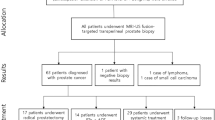Abstract
We evaluated the value of the ‘alternative slices mirror image method’ used in prostate tissue banking in terms of predicting the sampling of cancerous tissue while preserving the pathological prognostic information. The concordance of diagnosis between banked sections and their mirror image paraffin- sections was studied using 50 cases corresponding to 400 H&E sections taken from 400 banked frozen blocks (two presumed benign and two presumed cancer for each case). The mean number of paraffin blocks in each case was 21. On average 29% of the prostate gland was banked and banked tissue contained cancer in 47 cases (94%). There was no difference between the concordant and discordant groups in terms of the final Gleason score, pathological stage, prostate size, number of banked blocks and the percentage of the prostate submitted for banking. However, concordant cases had larger foci of cancer in the mirror image paraffin block (P = 0.0088). In addition, the surgical margins sections which are not banked using this method provided important information about the pathological stage, surgical margins status and the final Gleason score in 2.6, 2.6, and 1.3% of cases, respectively. The ‘alternative slices mirror image method’ is a straightforward method that is highly efficient in banking prostatic cancerous tissue. Overall, tumor volume and especially size of tumor foci in the image paraffin block are the most important factors in dictating the success rate of banking frozen cancerous tissue. Including ‘surgical margins’ sections for histology provides additional important prognostic information in a minority of cases.


Similar content being viewed by others
References
Bova GS, Fox WM et al (1993) Methods of radical prostatectomy specimen processing: a novel technique for harvesting fresh prostate cancer tissue and review of processing techniques. Mod Pathol 6(2):201–207
Cohen MB, Soloway MS et al (1994) Sampling of radical prostatectomy specimens. How much is adequate? Am J Clin Pathol 101(3):250–252
Dhir R (2008) Prostate cancer biobanking. Curr Opin Urol 18(3):309–314
Epstein JI, Allsbrook WC Jr et al (2005) The 2005 International society of urological pathology (ISUP) consensus conference on Gleason grading of prostatic carcinoma. Am J Surg Pathol 29(9):1228–1242
Grossfeld GD, Chang JJ et al (2000) Does the completeness of prostate sampling predict outcome for patients undergoing radical prostatectomy?: data from the CAPSURE database. Urology 56(3):430–435
Hall GS, Kramer CE et al (1992) Evaluation of radical prostatectomy specimens. A comparative analysis of sampling methods. Am J Surg Pathol 16(4):315–324
Hollenbeck BK, Bassily N et al (2000) Whole mounted radical prostatectomy specimens do not increase detection of adverse pathological features. J Urol 164(5):1583–1586
Kim K, Pak PJ et al (2009) Limited sampling of radical prostatectomy specimens with excellent preservation of prognostic parameters of prostate cancer. Arch Pathol Lab Med 133(8):1278–1284
Mazzucchelli R, Santinelli A et al (2002) Evaluation of prognostic factors in radical prostatectomy specimens with cancer. Urol Int 68(4):209–215
McConnell JD (2001) The development of urology in the 21st century. BJU Int 88(Suppl 2):2–6 (discussion 49–50)
Riddick AC, Barker C et al (2003) Banking of fresh-frozen prostate tissue: methods, validation and use. BJU Int 91(4):315–323 (discussion 323–324)
Sehdev AE, Pan CC et al (2001) Comparative analysis of sampling methods for grossing radical prostatectomy specimens performed for nonpalpable (stage T1c) prostatic adenocarcinoma. Hum Pathol 32(5):494–499
Sircar K, Gaboury L et al (2006) Isolation of human prostatic epithelial plasma membranes for proteomics using mirror image tissue banking of radical prostatectomy specimens. Clin Cancer Res 12(14 Pt 1):4178–4184
True LD (1994) Surgical pathology examination of the prostate gland. Practice survey by American society of clinical pathologists. Am J Clin Pathol 102(5):572–579
Williamson M, Naaby-Hansen S et al (2001) 21st Century molecular biology in urology. BJU Int 88(5):451–457
Acknowledgments
This study was funded in part by Procure Alliance, a charitable organization based in Quebec dedicated to the fight against prostate cancer.
Conflict of interest
All the authors do not have competing financial interests in relation to the work described.
Author information
Authors and Affiliations
Corresponding author
Rights and permissions
About this article
Cite this article
Brimo, F., Sircar, K., Chevalier, S. et al. Banking of fresh-frozen prostate tissue using the alternate mirror image protocol: methods, validation, and impact on the pathological prognostic parameters in radical prostatectomy. Cell Tissue Bank 13, 631–638 (2012). https://doi.org/10.1007/s10561-011-9284-y
Received:
Accepted:
Published:
Issue Date:
DOI: https://doi.org/10.1007/s10561-011-9284-y




